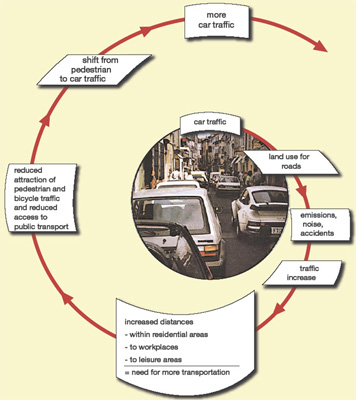 |
 |
 |
 |
 |
 |
 |
 |
 |
 |
 |
Important issues
Transport is a complex system that consists of building and maintaining the infrastructure, management and guidance of the traffic, and operating – either individually or on commercial or public basis. Not only decisions on the infrastructure have influence on the sustainability of the system, but also e.g. decisions on taxation, pricing etc.
Transport infrastructure is a network of streets, roads, railroad sections, public transport routes etc. In most cases it’s not clever to evaluate the sustainability of an individual infrastructure project alone – there is a series of almost similar cases (even if the evaluation results might be useful to compare projects with similar cases in other cities and regions). The sustainability assessment done once for one type of a project is valid in most individual cases.

Without a sustainable transport policy the urban transport tends to form a traffic circle (Wuppertal Institut, (4)).
What matters is the strategic choice: which type of projects are chosen to be implemented, e.g. is the individual car traffic favoured by new roads or is the public transport developed by new rails or bus routes - what is the transport policy? The environmental impacts of an individual project have to be assessed of course, but in most cases the results can only affect on the way of implementing the project, but not on choosing if the project will be implemented or not. Assessing the sustainability of an individual project as a whole is often unfruitful, because the project is a part of a strategy only.
In urban areas, the administrative situation brings even more complexity to evaluating the sustainability of the projects, and decision-making. E.g. in Finland both the state organisations (Road Administration, State Railroads etc.), several municipalities and on the Capital Area also the region are actors financing and implementing infrastructure projects. They all have different targets and criteria for this.
The traditional approach to transport planning has been driven by the improvement of mobility standards, accompanied by serious attempts to reduce the environmental impact of transport systems. Indeed, mobility policies have been geared towards the supply side of the urban transport system, emphasising the environmental gains obtained through more attractive, diversified and energy efficient public transport, coupled with better and safer walking and cycling facilities, innovative traffic management strategies and priority to zero emission cars.
More recently, the virtues of land use planning aimed at reducing the demand for transport have been rediscovered. Wise land use planning is able to reduce overall travelling needs and travelling distances, namely through more compact and mixed use planning policies.
Having said that, the very challenge in the transport sector lies on the adoption
of a more ambitious notion of accessibility that would embrace not only the
objective of reducing current needs for travelling but also a further exploration
of the full potentials of telecommunications in present information age in order
to avoid physical transport..
For more information:
Overall impact of a new transport connection or the improvement of the capacity of an existing one
Speed limits in residential areas and city centres